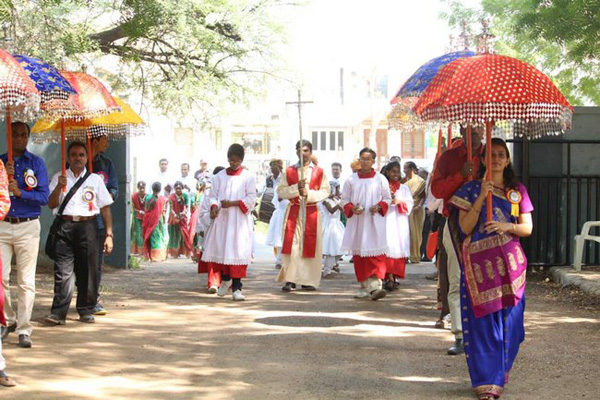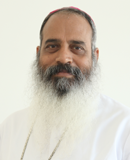Archdiocese of Gandhinagar |
||||||||||||||||||||
|---|---|---|---|---|---|---|---|---|---|---|---|---|---|---|---|---|---|---|---|---|
 |
||||||||||||||||||||
Rite: |
Latin | Population: |
10,301,342 | |||||||||||||||||
Status: |
Archdiocese | Catholics: |
21053 | |||||||||||||||||
Founded: |
11-Nov-02 | Diocesan Priests: |
32 | |||||||||||||||||
| Total area: | 13961 sq km |
Religious Priests: |
34 | |||||||||||||||||
Province: |
Gandhinagar |
Religious Sisters: |
85 | |||||||||||||||||
Region: |
Western |
Seminarians: |
||||||||||||||||||
| Patron: | Sacred Heart of Jesus & Our Lady of Queen of the World |
|||||||||||||||||||
| Languages: | Gujarati Bhili English Malayalam Tamil and Konkani | |||||||||||||||||||
| Civil States: | Gujarat: Gandhinagar Mehsana Patan Banaskantha and Sabarkantha | |||||||||||||||||||
Contact Archdiocese Office : |
Archbishop's House Sector 8 Gandhinagar 382 008. GUJARAT. | |||||||||||||||||||
Telephone 1:
|
079-23 22 75 41 / 23 22 19 12 | Fax: |
23 22 19 12 |
|||||||||||||||||
E-Mail Office: |
gandhinagardioc@gmail.com | Website: |
||||||||||||||||||
|
Most Rev. Thomas Ignatius Macwan, Archbishop of Gandhinagar |
||||||||||||||||||||
 |
||||||||||||||||||||
|
Name: |
Most Rev. Thomas Ignatius Macwan | |||||||||||||||||||
|
Designation: |
Archbishop | Canonical Possession: | 2015- | |||||||||||||||||
Telephone (P): |
||||||||||||||||||||
| E-mail (P): | ||||||||||||||||||||
| Other Present & Retired Ordinaries of the Archdiocese of Gandhinagar | ||||||||||||||||||||
|
||||||||||||||||||||
| Pilgrim Centres in theArchdiocese of Gandhinagar | ||||||||||||||||||||
|
Ecclesiastical Institutions |
Social / Charitable Institutions / Care Centres |
Educational Institutions |
||||||||||||||||||
Parishes: |
20 |
Hospitals: |
1 |
Degree Colleges: |
||||||||||||||||
Major Seminaries: |
Orphanages: |
2 |
Technical Training Centres: |
2 |
||||||||||||||||
Minor Seminaries: |
Special Schools: |
High Schools: |
13 |
|||||||||||||||||
Monastries: |
Crèches: |
Lower Primary Schools: |
14 |
|||||||||||||||||
Convents: |
Counselling Centres: |
Presses & Media Centres: |
||||||||||||||||||
Formation Houses: |
1 |
Social Centres: |
6 |
Professional Colleges: |
||||||||||||||||
Retreat Centres: |
Dispensaries / Clinics: |
3 |
Parallel Colleges: |
|||||||||||||||||
Physically Challenged: |
Higher Secondary : |
11 |
||||||||||||||||||
Boarding Houses: |
Upper Primary Schools: |
6 |
||||||||||||||||||
HIV / AIDS Centres: |
Nurseries/Pre-Primary : |
55 |
||||||||||||||||||
De-addiction Centres: |
||||||||||||||||||||
| Aged & Destitute: | 1 | |||||||||||||||||||
History of the Archdiocese of Gandhinagar |
||||||||||||||||||||
| From 1829 to 1901 Deesa was a British military Cantonment with a resident Catholic Chaplain and a Chapel. There were many times when the Catholic (mainly Irish) military personnel were as many as 500 necessitating the services of the Catholic Chaplain. With the shifting of the Cantonment the Chapel was in disuse and allowed to disintegrate. The statue of Our Lady Queen of the World found refuge in Khambholaj where for many years she was honoured as Our Lady of Khambholaj : Anathoni Mata. When the statue of Mother of the Forsaken from Valencia (Spain) was enthroned in the new Church of Khambholaj Our Lady Queen of the World was returned around 1980 to the newly founded mission of Deesa. From 1936 from Rajkot Fr E. Gadea sj began visiting Deesa Radhanpur Mehsana Palanpur celebrating Holy Mass for the dispersed Catholics of the Railways and other government establishments or in the service of the Nawabs. With India becoming independent in 1947 many refugees from Pakistan entered the northern regions of Gujarat. Among these were the Majirana tribals some of whom were baptized Catholics of the Nawabshah mission in Sind. In new surroundings and with no immediate presence of the Church they lost contact with the Church. In the late sixties a chance encounter of one of these Catholics with a Catholic Railway official led to the discovery of this community of Catholics who were spread out in villages of Radhanpur and Deesa Talukas. By this time Kalol mission was in existence. Ahmedabad Diocese and the Gujarat Jesuits under the inspiration of Bishop Edwin Pinto sj and Fr. Charles Gomes sj respectively sent Jesuit Priests to begin missions in North Gujarat and Sabarkantha. Fr M. Diaz Garriz sj in Kalol (established 1964) and Swamy Dindayanad (Fr. Luis Espasa sj) in Mankroda-Bhiloda (established 1964) began mission work in their respective areas. The next Jesuit Provincial Fr. Francis Braganza sj (later Bishop of Baroda) and successive Provincials supported these initiatives and the missions grew over the years : Nana Kantharia Vijayanagar Meghraj in Sabarkantha and Kadi (Unteshwari) Mehsana Deesa Radhanpur in North Gujarat. In 1960 Gujarat was established as a separate state and Gandhinagar was developed as the state capital. Jesuit Fathers and Sisters of Apostolic Carmel were invited to open their respective schools and the Parish was established in 1970. In 1974 the visionary missionary Fr. Charles Gomes sj was appointed Bishop of Ahmedabad. Besides giving a fresh impetus to the missions already established he planned for Parish Centers and Institutions in important towns and district headquarters of the hitherto little attended North Gujarat. He dreamed of a new Diocese in North Gujarat. Parishes and Schools Centers for Legal Aid and other Institutions were planned for Modasa and Himmatnagar Patan and Palanpur laying the foundation for a new Diocese. His successor Bishop Stanislaus Fernandes sj brought the dream to reality. On 11 November 2002 Gandhinagar the capital of Gujarat was established as an Archiepiscopal See and Bishop Stanislaus Fernandes sj was named Archbishop. The territory of the new Archdiocese comprises the districts of Gandhinagar Mehsana Patan Banaskantha and Sabarkantha. The newly appointed Archbishop took formal possession of the Archdiocese on 22 December 2002 in Gandhinagar in the presence of representatives of all the new Catholic communities of North Gujarat. The Archdiocese of Gandhinagar is a young Church with most of the Catholics entering the second generation. The Archbishop called an Assembly of the Priests and Religious of the Archdiocese on 12 February 2003 to prepare a Vision Statement for the Archdiocese. There were further meetings in local groups in preparation for a second Assembly on 12 August 2003 to which Major Superiors were also invited. The generous participation of so many Superiors was an encouragement to the young mission that the Archdiocese is in reality. With the inspiration of the Major Superiors a Mission Statement was discussed and accepted and the stage set for opening new missions. With a few senior and younger Diocesan Priests of Ahmedabad joining the small band of Gandhinagar missionaries the Archdiocese has initiated steps for the establishment of new missions in Mehsana and Banaskantha districts. Besides the presence of Gujarat Jesuits and other women Religious Congregations in the Archdiocese the support of other Religious groups has been sought to bring to fruition the Vision and the Mission of the Archdiocese. |
||||||||||||||||||||
|
|
||||||||||||||||||||
| Prelates of the Archdiocese of Gandhinagar | ||||||||||||||||||||
